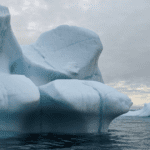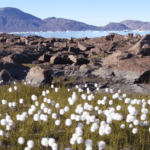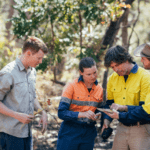The first animated GIF I ever made was a flaming red danger sign. The year was 1997, and I’d just started my own graphic design page on the free website-building platform, Geocities. The most popular GIF at the time was the Dancing Baby, known for its appearance that same year on the TV show Ally McBeal. My GIF obsession started as a childhood hobby but has since become a major part of my job as a science communicator. These fun flickering images are an efficient and effective form of digital communication and should be used more as a science communication tool.
The GIF (Graphics Interchange Format) hit its 30-year anniversary this year. Since its creation, the World Wide Web has transformed into Web 2.0 thanks to the digital takeover of social media platforms like Twitter, Facebook, and Tumblr. In that time, I’ve watched the GIF go from being used as a pixelated dancing banana to one of the most engaging climate change figures created to date.
These days, GIFs are so widely used that I often find myself staring at a static image waiting for it to move. From memes and looping video clips to reaction GIFs and realistic moving images, advertisements, social media conversations, and the internet as a whole just wouldn’t be the same without GIFs.
GIFs and science communication
I’m lucky enough to work as a science communicator full time which means I’m constantly looking into how best to communicate data and tell science stories to various audiences. In my case, the story is about climate change. Inspired by the animated data visualizations I’ve seen online over the last couple years, a colleague and I have been working on creating GIFs to communicate temperature increases in Ontario, Canada. But animating data is just one of many ways GIFs can be used for science communication, I’ve outlined a summary of what you can use them for below:
To visualize data
Complex charts such as scatterplots with trend lines and error bars are a communication barrier to those who don’t encounter these graphs on a daily basis. Visualizing scientific data in accessible formats is one of the major hurdles of communicating science to the public. GIFs can be used to break datasets down into digestible segments and show moving trends in ways a static figure cannot. Seeing a plot can be intimidating to a reader; animating data is an excellent way of displaying how data points change in an aesthetically appealing and engaging way that is also understandable. Great examples of such visualizations include a spiralling global temperature chart (shown above), NASA’s growing temperature plot, and a map of the annual migration of birds:
One of my favourite ways GIFs are used in science communication is to show change, especially when it comes to global climatic change. Examples include showing the loss of Arctic sea ice, demonstrating water loss from drought, and revealing melting glaciers.
To communicate change
GIFs have so much potential as an educational tool. Imagine while studying, your textbooks came to life. You could watch the continental plates shifting over time, watch planets orbitaround the sun in our solar system, or learn about the stages of human embryo and fetus development. One fantastic teacher made a GIFtionary teaching package to go along with his earth science class as an online learning resource. The Amoeba Sisters is a science comic that often uses GIFs to simply explain complex scientific processes, such as the stages of mitosis and protein synthesis. GIFs can also be used to teach people about how science is done, as seen with this egg collection GIF posted by a fish biologist on Twitter from her field work experience.
To enhance education
GIFs have so much potential as an educational tool. Imagine while studying, your textbooks came to life. You could watch the continental plates shifting over time, watch planets orbitaround the sun in our solar system, or learn about the stages of human embryo and fetus development. One fantastic teacher made a GIFtionary teaching package to go along with his earth science class as an online learning resource. The Amoeba Sisters is a science comic that often uses GIFs to simply explain complex scientific processes, such as the stages of mitosis and protein synthesis. GIFs can also be used to teach people about how science is done, as seen with this egg collection GIF posted by a fish biologist on Twitter from her field work experience.
To summarize videos
Showing clips of viral science videos or nature documentaries is another way to use GIFs for science communication. In a world where we are always running out of time, many readers won’t bother watching a full video, so capturing a clip may be the best way to communicate a scientific concept—take for example this snippet of a video showing a dividing frog zygote, which brings new life to classic cell division. The moment an octopus catches a crab brings the ocean to an audience using only a few seconds of video. Watching a stealthy caterpillar capture its prey in slow-motion reveals what can be missed in the blink of an eye. My favourite science education video of all time is a short piece about how spiders tune their webs like guitars, and I first learned about it from a GIF on the Skunk Bear Tumblr.
To catch attention
There are a lot of silly but memorable GIFs out there that can be used to engage audiences in science. For example, a GIF of Canadian rapper Drake has been used to explain how the Na+/K+ pump in cells works. Reaction GIFs are one way to effectively catch an audience’s attention and draw them into a science story, or they could be used to emphasize the importance of a scientific discovery. Reaction GIFs featuring Bill Nye the Science Guy are some of the most popular science-related images online. GIFs can also be awe-inspiring, with beautiful looping clips of nature or the view of our planet from the International Space Station.
Science writers use GIFs!
Animated GIFs are being used in science blogs and articles in major newspapers and magazines across the web. In professional science pieces, GIFs are often used to illustrate or clarify a point in the article. For example, a science writer used a GIF of a gannet diving in slow motion into water as part of an article about seabird diving behaviour.
Animate your presentations
Another article on how baby starfish feed included an animated image of the water vortexcreated by a foraging larvae. More lightheartedly, RadioLab’s Robert Krulwich used hand drawn animated cartoons in his piece about the Clark’s nutcracker. Science GIFs also regularly appear on the Twitter accounts of several prominent science communicators including those of Kyle Hill from Nerdist, Sarah Keartes, and Canada’s own Quirks & Quarks.
Another great place for using GIFs in science communication is embedded in your presentation slides. It’s especially easy to do so using Google Slides, as you can even search for GIFs within the application. PowerPoint allows GIFs too; the next conference presentation you give, insert a GIF as you would a video and engage your audience like never before.
Find science GIFs
Some of the best places to find science-related GIFs are:
- Google Images—Type in the topic you’re looking for in the Google search bar. Specify the type of image as a GIF under Tools>Type>Animated
- Giphy—Search and find GIFs by any topic
- Reddit Science GIFs—Collections of science-related GIFs
- Tumblr—Many science GIFs live on this social blogging platform
- Imgur Science—The most awesome images on the Internet
- Reaction GIFs—Never ending supply of reaction GIFs for every emotion
Make your own science GIFs
Not finding the right science GIF? Want to GIF your own work? You can easily make GIFs using websites, mobile apps, and programs.
Programs
Making GIFs on your computer can be done using image editors, recorders, and graphic design programs:
- ImageMagick
- Adobe Photoshop (or the open-source program GIMP)—check out this GIF tutorialon how to make GIFs in Photoshop!
- Giffing Tool
Websites
There are several options for uploading your own images to easily create GIFs online:
Apps
There are many mobile apps out there that make it super easy to create GIFs:
The next paper you read or publish, tweet your thoughts with a reaction GIF, write an article summarizing it in a series of animations, or create a GIF of your lab work and post it on Instagram. No matter how you pronounce it, GIFs are a powerful science communication tool.
Get creative, make it fun, and start GIF-ing—for science!




